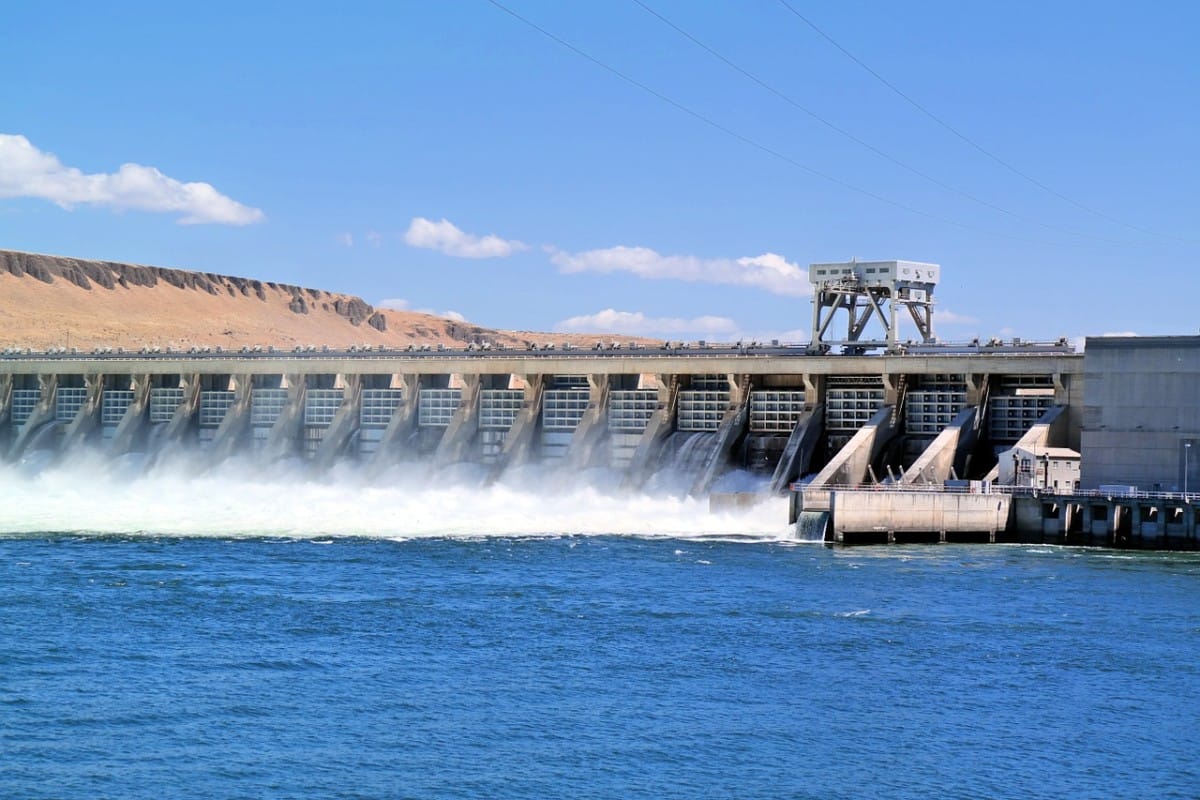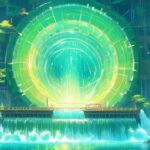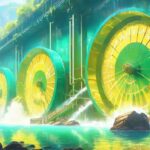Let’s dive into the fascinating world of hydroelectricity, an energy source that’s as fun as it is important! From its humble beginnings to its role in powering our modern world, we’ll uncover surprising facts, explore leading hydropower nations, and discover how this age-old energy game works. Get ready to spark your curiosity!
Fun Facts About Hydroelectricity
Ever wondered how water transforms into electricity? That’s the magic of hydroelectricity! Picture a rushing river or a powerful waterfall – that’s the energy hydroelectricity harnesses. By channeling this natural force, we can generate clean electricity without producing harmful greenhouse gases.
Think of it like a giant water wheel, much like those you see in old movies. As water flows and pushes against the wheel, it spins. Hydroelectricity works similarly, using a turbine instead of a wheel. The flowing water spins the turbine, generating electricity!
Ready for some electrifying facts about hydroelectricity?
- Pumped-Storage: Power on Demand! Imagine two large pools of water at different elevations. When electricity demand is low, like at night, water is pumped uphill to the higher pool. This stored water is like a giant battery. When demand spikes, the water flows downhill through a turbine, instantly generating power!
- A Dam Good Fact! The world’s largest hydroelectric dam, the Three Gorges Dam in China, is an engineering marvel. This behemoth boasts 32 turbines, producing enough electricity to power a city the size of Beijing. It’s a testament to the sheer scale of hydropower!
- Nature’s Gift that Keeps on Giving! Unlike fossil fuels, which are finite, hydroelectricity relies on the renewable water cycle. As long as we have rivers and rainfall, we can generate hydropower. Talk about sustainable energy!
- Holding Back the Tide (Literally!) Hydroelectric dams are more than just power generators – they can also protect us from floods. These massive structures act as reservoirs, capturing and storing vast amounts of water to prevent downstream flooding. During droughts, they release water, ensuring a consistent supply for rivers and lakes.
- Environmental Impact: A Delicate Balance. While hydropower is clean and renewable, it’s essential to acknowledge its potential environmental impact. Building large dams can alter river flow, impacting fish migration and delicate ecosystems. Carefully evaluating these impacts and implementing mitigation strategies, like fish ladders (more on those later!), is crucial for responsible hydropower development.
- Fishy Staircases to the Rescue! Ever heard of fish ladders? They’re ingenious structures built into dams to help fish bypass these man-made barriers. These “staircases” offer a safe passage for fish to swim upstream, reaching their spawning grounds and ensuring the health of fish populations.
Hydroelectricity alone might not be the silver bullet to our energy needs, but it’s a critical part of the solution. Currently, it provides approximately 16% of the world’s electricity. As we strive for a sustainable future, hydroelectricity will undoubtedly play a vital role in powering our world!
What are 5 facts about hydroelectric energy?
Let’s delve deeper into the world of hydroelectric energy and uncover some fascinating “Did You Know?” nuggets!
- Water-Powered Battery: Hydroelectricity might seem magical, but it’s all about harnessing the power of nature. Picture water flowing downhill, just as gravity intended. Now, imagine using that force to spin turbines, similar to giant water wheels. This spinning action generates electricity without releasing harmful greenhouse gases.
- From Small Town to Big Power: Appleton, Wisconsin, might not be the first place that pops into your head when you think of energy revolutions. However, this unassuming town made history in 1882 by launching the first commercial hydroelectric power plant in the US, Igniting a nationwide trend.
- America’s Energy Powerhouse: While coal and natural gas currently hold the top spots, hydropower proudly claims third place in US electricity production. That’s a pretty big deal considering the diverse ways we generate electricity today!
- Built to Last (and Last!) In a world of rapidly evolving technology, hydropower plants stand the test of time. These sturdy structures are built to last, often churning out clean energy for 50 to 100 years, sometimes even longer! Talk about a wise investment!
- Nature’s Balancing Act: While hydropower boasts clean energy credentials, it’s crucial to acknowledge its potential environmental impacts. Building dams can alter natural river systems, potentially disrupting fish migration and transforming landscapes by creating reservoirs. Responsible hydropower development involves carefully evaluating these impacts and adopting measures to minimize any negative effects. Scientists and engineers are constantly innovating to make hydropower even more sustainable!
What is an interesting fact about hydropower for kids?
Imagine a power plant so massive it could dwarf a town! Some hydropower plants are truly gigantic!
One mind-blowing fact about hydropower is that the world’s largest hydropower plant, the Three Gorges Dam in China, is so colossal that it’s believed to have slightly slowed down the Earth’s rotation! Don’t worry, it’s not something we’d ever notice in our daily lives, but it highlights the sheer power harnessed from the flow of water.
The US boasts some impressive hydropower plants as well. The iconic Hoover Dam, built back in the 1930s, is an engineering marvel. It’s so massive that you can see it from space! It held the title of the world’s largest hydropower plant for a significant time, showcasing the remarkable power of moving water.
These colossal structures illustrate the immense power of moving water and our ability to harness that power for clean energy.
Who has the most hydroelectric power in the world?
When it comes to harnessing the power of water for electricity, China reigns supreme. They are miles ahead, producing a staggering 71% of the entire planet’s hydroelectric power. China has strategically invested in massive dam projects and harnessed its vast network of rivers to become the undisputed hydropower leader.
But China isn’t alone in its hydropower endeavors. Other nations are also making significant strides. The United States, along with Brazil, Canada, India, and Russia, are all harnessing the power of their rivers with impressive hydropower infrastructure. Hydropower plays a significant role in meeting their electricity demands.
Speaking of impressive, the Three Gorges Dam in China stands as a testament to hydropower’s potential. This colossal structure holds the title of the world’s largest hydroelectric power plant, generating an astounding amount of electricity.
In the United States, hydropower is particularly crucial for states near the Pacific Ocean, like Washington. In 2015, Washington State generated over 30% of its electricity from hydropower, showcasing its commitment to this renewable energy source.
While we have a good understanding of the major players in the hydropower arena, the landscape is constantly evolving. As new data emerges, technologies advance, and perspectives shift, the future of hydropower holds exciting possibilities. Some experts believe that with the pressing need for cleaner energy sources, hydropower will play an even more crucial role in the future.
So, while China wears the hydropower crown for now, the future of this renewable energy source is full of potential and intrigue!
How old is hydroelectricity?
Hydroelectricity, the practice of using moving water to generate power, has been around for much longer than you might think! Turns out, our ancestors were pretty clever at harnessing the power of nature.
Way back in ancient Greece, amidst the towering stone structures and early inventions, people were already utilizing hydropower! They used the force of water to power their grain mills, demonstrating an early understanding of harnessing water’s energy.
Fast forward to 1882 – the year the first commercial hydroelectric power plant was established in Appleton, Wisconsin. This marked a significant milestone, showcasing hydropower’s potential to provide electricity on a larger scale.
Since then, hydropower has experienced remarkable growth, becoming a key player in the global clean energy landscape. And for good reason! Hydropower doesn’t involve burning fossil fuels, so it doesn’t release harmful greenhouse gases into the atmosphere. Additionally, hydroelectric power plants are built to stand the test of time, often operating for 50 to 100 years or more.
Consider this: Today, hydropower ranks as the third-largest source of electricity in the United States. And let’s not forget the incredible feats of engineering around the world, like the massive Three Gorges Dam in China – a testament to how far hydropower has come.
Here’s a quick snapshot of hydropower’s journey:
| Feature | Description |
|---|---|
| Origin | Ancient Greece (for powering grain mills) |
| First Commercial Plant | 1882, Appleton, Wisconsin, USA |
| Current Ranking (USA) | Third-largest source of electricity |
| Environmental Impact | Sustainable, eco-friendly, no greenhouse gas emissions |
| Lifespan of Power Plants | 50 to 100 years |
While we’ve come a long way, research and development in hydropower are ongoing. The methods for harnessing and utilizing hydropower are constantly evolving, promising exciting advancements in the future.
Is Hydropower Expensive?
Hydropower has a reputation for being good for the environment, but what about our wallets? Are these massive dams and power plants budget-busters?
Here’s the good news: once a hydropower plant is up and running, it’s among the most affordable ways to generate electricity. The “fuel” is water, a naturally replenished resource, so there are no fluctuating fuel costs like those associated with coal or natural gas. Moreover, these sturdy power plants are built to last, often requiring minimal maintenance and operating for 50 to 100 years or more. Over time, the initial investment is distributed, making it a financially savvy choice in the long run.
However, it’s essential to acknowledge that building a hydropower plant, particularly a large-scale project with a massive dam, can be quite expensive. Imagine constructing a dam in a remote mountain range – transporting materials, navigating challenging terrain – it all adds up! The complexity of the project directly impacts the initial price tag.
To give you a sense of the cost, in 2018, the global average cost for hydropower electricity was just under 5 cents per kilowatt-hour, making it highly competitive compared to other energy sources!
So, is hydropower expensive? The answer, like many things in life, is nuanced. It’s a balancing act between the higher initial investment and the long-term savings derived from generating cheap, clean energy. What might seem like a significant upfront cost can be a prudent financial decision considering the long-term benefits, especially when factoring in the environmental advantages.
Researchers are constantly exploring innovative designs and technologies to make hydropower construction more efficient and cost-effective. It’s an exciting field with immense potential for future advancements!
What are 5 cons of hydropower?
While hydropower offers numerous benefits, it’s crucial to acknowledge its potential downsides.
- Environmental Disruption: Building a large dam can significantly impact river ecosystems. Imagine a giant wall suddenly appearing in a river, disrupting the natural flow and impacting the delicate balance of life. Fish migration patterns can be disrupted, water temperature changes can affect aquatic species, and the flooding of land to create reservoirs can displace plants and animals. While these impacts can be mitigated, they are important considerations.
- Community Displacement: The construction of large dams often necessitates the flooding of surrounding land, which can displace communities. While compensation is typically offered, being uprooted from homes and ancestral lands can have significant social and cultural impacts.
- High Upfront Costs: Building a hydropower plant, especially a large-scale project, involves significant upfront investment. These costs can be a barrier for developing countries seeking to expand their renewable energy capacity.
- Water Resource Conflicts: Dams regulate water flow, which can lead to conflicts over water usage, particularly during periods of drought. Balancing the needs of hydropower generation with the water requirements of communities and ecosystems downstream is crucial.
- Risk of Dam Failure: While dam failures are rare, they can be catastrophic, resulting in widespread flooding and potential loss of life. Ensuring dam safety and implementing rigorous maintenance protocols are essential for mitigating this risk.
Striving for Balance:
Hydropower offers a renewable energy source, but it’s essential to weigh the pros and cons carefully. Finding a balance that benefits both people and the planet is key. Ongoing research is exploring ways to make hydropower more sustainable and minimize its impacts. The future of hydropower likely lies in finding innovative solutions that harness the power of water responsibly and effectively.
What are 6 benefits of hydropower?
Hydropower, the generation of electricity from water, offers a range of benefits that make it an attractive renewable energy source.
1. Environmentally Friendly: One of hydropower’s most significant advantages is its minimal environmental footprint. Unlike fossil fuel power plants, hydropower doesn’t release harmful pollutants into the air, making it a clean and sustainable energy source that combats climate change.
2. Reliable and Responsive: Hydropower plants are remarkably adaptable, capable of rapidly increasing or decreasing their electricity output to meet fluctuating energy demands. This “on-demand” characteristic makes them highly reliable for maintaining grid stability.
3. Grid Stabilizer: Think of hydropower as a balancing force for the electricity grid. It helps smooth out the fluctuations caused by intermittent renewable sources like solar and wind power, which depend on weather conditions. This stabilizing effect ensures a consistent and dependable power supply.
4. Multipurpose Resource: Hydropower projects are versatile, offering benefits beyond electricity generation. They can play a vital role in flood control by regulating water flow, contribute to irrigation systems by providing water for agriculture, and even offer recreational opportunities through the creation of reservoirs suitable for boating and fishing.
5. Cost-Effective (in the Long Run): In regions with abundant water resources, hydropower is often a cost-effective electricity generation method. While initial construction costs can be significant, hydropower plants typically have low operating costs, making them economically attractive over time.
6. Ecological Benefits: Believe it or not, hydropower projects can enhance the surrounding ecosystem in some cases. The creation of reservoirs and the management of water flow can create new habitats, potentially boosting biodiversity in the area.
Important Note: While hydropower presents many advantages, it’s essential to acknowledge that no energy source is without its drawbacks. Dam construction can sometimes affect natural river ecosystems and fish migration patterns. Scientists and engineers are constantly researching and developing ways to minimize these impacts and make hydropower even more sustainable.
What are the 10 advantages of using a hydroelectric power plant?
Let’s delve into the specific advantages of hydroelectric power plants that make them a promising component of a clean energy future.
1. Dependable and Consistent: Hydropower is like that reliable friend you can always count on. Unlike solar and wind power, which can be intermittent due to weather fluctuations, hydropower relies on the relatively consistent flow of water, ensuring a stable and predictable energy source.
2. Clean Energy Champion: One of the most significant advantages of hydropower is its clean energy profile. Hydroelectric plants don’t produce greenhouse gases or air pollutants, making them a key player in mitigating climate change and improving air quality.
3. Sustainable and Renewable: Hydropower relies on the natural water cycle – a process that’s constantly renewed. Unlike fossil fuel power plants that consume finite resources and pollute the environment, hydropower offers a sustainable energy solution for generations to come.
4. Cost-Effective Operation: While upfront construction costs can be substantial, hydropower plants have relatively low operating costs once operational. This translates into lower electricity bills and more financial resources for other essential needs.
5. Flood Control Benefits: Hydroelectric dams can serve a dual purpose, acting as flood control mechanisms by regulating water flow. This capability can protect downstream communities from the devastating impacts of flooding.
6. Water Quality Enhancement: Hydropower dams can play a surprising role in improving water quality. By trapping sediments and pollutants that would otherwise flow downstream, they contribute to cleaner water resources.
7. Job Creation: Building and maintaining hydropower plants creates jobs in various sectors, from engineering and construction to plant operation and support services. This job creation can boost local economies.
8. Electrifying Remote Areas: Providing electricity to remote and underserved communities can be challenging. Hydropower offers a solution by enabling the construction of power plants in areas where other energy sources might not be feasible.
9. Reducing Reliance on Foreign Oil: Hydropower can enhance energy independence by allowing countries to utilize a domestic energy source, reducing their dependence on foreign oil and enhancing energy security.
10. Long-Term Sustainability: Hydropower is a sustainable energy source that can provide clean electricity for generations without depleting natural resources or harming the environment. It represents a long-term solution for a cleaner energy future.
Important Considerations:
While hydropower offers numerous advantages, acknowledging and addressing potential drawbacks is vital. Ongoing research and development focus on minimizing the impact of dams on ecosystems and improving the environmental sustainability of hydropower projects.
What are 3 Concerns About Hydropower?
While hydropower is often praised for its clean energy potential, it also faces valid concerns that require careful consideration.
1. Ecological Disruption
Building a large dam can significantly alter river ecosystems, much like erecting a wall in the middle of a bustling town. Fish migration routes can be blocked, water temperatures can change, and the creation of reservoirs can submerge terrestrial ecosystems, potentially displacing species. Additionally, research suggests that in some instances, damming rivers can contribute to increased greenhouse gas emissions. The decomposition of organic matter in flooded areas can release methane, a potent greenhouse gas. Scientists are still studying the complex relationship between hydropower and greenhouse gas emissions, but it’s a factor that merits attention.
2. Social and Economic Displacement
Building a large dam isn’t just about pouring concrete; it can involve relocating communities, sometimes from land they’ve called home for generations. This displacement can disrupt livelihoods, cultural heritage, and the social fabric of communities. It’s vital to recognize and address the human cost of hydropower projects and ensure that communities are treated fairly and equitably.
3. Financial Implications
Constructing a hydropower plant, especially one with a massive dam, requires significant financial investment. These high upfront costs can be a barrier for developing countries seeking to expand their renewable energy capacity. Additionally, maintaining and operating these plants over their long lifespans requires ongoing financial commitment.
Thinking Long-Term:
Hydropower holds immense potential to provide clean energy, but it’s crucial to approach it responsibly, minimizing environmental damage and ensuring social equity. Ongoing research and technological advancements are key to improving hydropower practices and mitigating its impact on the planet.
Who are the five largest producers of hydropower?
When it comes to harnessing the power of water for electricity, a few countries stand out as true hydropower titans.
China dominates the global stage, producing nearly half of the world’s hydropower. China’s vast network of rivers and strategic investment in large-scale dam projects have propelled it to hydropower supremacy.
Following closely behind is Brazil, a country renowned for its incredible Amazon rainforest and its impressive hydropower potential. Canada, with its vast landscapes and abundant water resources, secures the third position.
India takes the fourth spot, demonstrating its commitment to hydropower as it addresses its growing energy demands. Rounding out the top five is the United States, a country with a long and storied history of harnessing hydropower, exemplified by iconic structures like the Hoover Dam.
These five countries collectively generate a staggering 75% of the world’s hydropower, providing a significant source of clean energy to power homes, businesses, and industries.
Here’s a closer look at the estimated hydropower generation of the top five producers:
| Rank | Country | Estimated Hydropower Generation (Terawatt-hours) |
|---|---|---|
| 1 | China | 1386 |
| 2 | Brazil | 430 |
| 3 | Canada | 401 |
| 4 | India | 171 |
| 5 | United States | 280 |
It’s important to note that these figures can vary from year to year depending on factors like rainfall and water levels. However, they provide a clear picture of the global leaders in hydropower generation.
While hydropower plays a crucial role in the global transition to renewable energy, it’s essential to acknowledge and address its potential environmental and social impacts. Ongoing research and sustainable development practices are crucial for harnessing the power of water responsibly.
Don’t forget to explore these other fascinating topics!
Do you know that the first microscope was invented in 1590 by two Dutch spectacle makers named Zacharias Janssen and his father Hans? Check out these fun facts about microscopes and be astonished by this brilliant invention.
While you are out in nature, have you ever wondered about the tiny black-legged tick that can carry harmful diseases? Click on fun facts about lyme disease to learn more!
- Unveiling Bernhard Caesar Einstein’s Scientific Achievements: A Legacy in Engineering - July 15, 2025
- Uncover who is Jerry McSorley: CEO, Family Man, Business Success Story - July 15, 2025
- Discover Bernhard Caesar Einstein’s Scientific Contributions: Unveiling a Legacy Beyond Einstein - July 15, 2025
















1 thought on “Powering Up the Fun: Surprising Facts About Hydroelectricity”
Comments are closed.